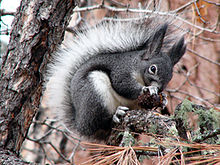Rocky Mountain ponderosa pine forest

The Rocky Mountain ponderosa pine forest is a forest plant community at an elevation of 2,000–2,700 metres (6,600–8,900 ft) in the U.S. state of Colorado, depending on soil moisture.[1][2]: 89 It is an important temperate coniferous forest ecoregion, including some endemic wildlife and grass species that are only found in this ponderosa pine (Pinus ponderosa) habitat.
Ecology[edit]

Ponderosa pine occurs as a mid-seral species and Douglas-fir is the climax forest in the Rocky Mountains. Quaking aspen and lodgepole pine are early-seral associates of ponderosa pine on these sites.[3][4][5]: 6 Ground-level vegetation includes ninebark (Physocarpus spp.), elk sedge (Carex geyeri), and pine grass (Calamagrostis rubescens). These species, in particular, exemplify aggressive survivors after disturbance (e.g., fire, mechanical site preparation) and are strong competitors for light and nutrients which compete with ponderosa pine seedlings.[6][5]: 6
Climate[edit]
The pure stands of Rocky Mountain ponderosa pine forest receive about 15–20 inches (380–510 mm) of annual precipitation.[7] In the northern Rockies, about 40-50% falls in April through September, while in the southern Rockies, about 66-75% falls during these months.[7] During these months there is high evapotranspiration because Populus tremuloides intercept a lot of the precipitation. The average temperature for this community is, on average, warmer than other conifer communities studied. The average temperature is approximately 5 to 8 °C (41 to 46 °F), creating 50-100 frost-free days per year.[1]: 7
Wildlife[edit]

The ponderosa pine forest, unlike the lodgepole pine and spruce/fir forests, supports numerous mammal species including Abert's squirrel (Sciurus aberti), which only lives in ponderosa pine communities.[8] S. aberti usually prefers a cluster of trees and feeds on the seeds of the cones. S. aberti has also adapted to the chemicals ponderosa pine produces for protection by targeting the trees that have lowered chemical levels. Pygmy nuthatches (Sitta pygmaea) are also adapted to ponderosa pine woodlands.[9] Another species that can be supported by ponderosa pine is the Colorado chipmunk (Tamias quadrivitattus). T. quadrivitattus helps spread the seeds of the ponderosa pine by spreading out and burying its caches. This results in the seeds being further from the trees and better germination rates. This community also hosts the gopher snake (Pituophis catenifera), which burrows into gopher holes. Also, ponderosa pine provides habitat for the cougar (Puma concolor) and the bobcat (Lynx rufus) as well as birds as western tanager (Piranga ludoviciana), wild turkey (Meleagris gallopavo), mountain bluebird (Sialia currucoides), and white-breasted nuthatch (Sitta carolinensis). The species present in this area affect the vegetation and provide aesthetic value for the people who use this area recreationally.
There is less canopy cover in a ponderosa pine community compared to a lodgepole pine (Pinus contorta) and spruce/fir community, resulting in more grasses, forbs, and shrubs. The high species richness of the understory in this community makes it preferred by grazing animals such as elk (Cervus elaphus), deer (Odocoileus hemionus), and moose (Alces alces).
Wildfire[edit]
In the northern Rocky Mountains of Idaho and western Montana, dry settings of ponderosa pine forests historically burned by low severity surface fires that did not kill overstory trees at 15 to 23 year mean return intervals.[5]: 7 Cultural burning by Native Americans augmented and even dominated burning in several locations.[10][5]: 7
Recreation[edit]
This section needs additional citations for verification. (May 2022) |
The ponderosa pine forest is a favored location for summer cabins and is often easily accessed. Much camping and four-wheel driving happens during the summer in the area also. Hunting is favored in the ponderosa pine forest because the trees are more spaced out than other conifer forests making for better range of sight, and the forest is lower and has less snow.
See also[edit]
- Ponderosa pine forest
- Colorado Rockies forests
- Rocky Mountain Floristic Region
- South Central Rockies forests
- Temperate coniferous forests
References[edit]
- ^ a b Peet, RK (1981). "Forest vegetation of the Colorado front range". Vegetatio. 45 (1): 3–75.
- ^ Peet, R. K. (1988). "Forests of the Rocky Mountains". In Barbour, M. G.; Billings, W. D. (eds.). North American terrestrial vegetation. New York: Cambridge University Press. pp. 63–101. ISBN 978-0-521-55986-7.
- ^ Mauk, RL; Henderson, JA (1984). Coniferous forest habitat types of northern Utah (Report). Ogden, UT: Intermountain Forest and Range Experiment Station, US Forest Service. General Technical Report GTR-INT-170.
- ^ Steele, R; Cooper, SV; Ondov, DM; Roberts, DW; Pfister, RD (1983). Forest habitat types of eastern Idaho-western Wyoming (Report). Ogden, UT: Intermountain Forest and Range Experiment Station, US Forest Service. General Technical Report INT-144.
- ^ a b c d
 This article incorporates public domain material from Graham, Russell T; Jain, Theresa B (2005). Ponderosa Pine Ecosystems. Proceedings of the Symposium on Ponderosa Pine: Issues, Trends, and Management. US Forest Service. USDA Forest Service Gen. Tech. Rep. PSW-GTR-198.
This article incorporates public domain material from Graham, Russell T; Jain, Theresa B (2005). Ponderosa Pine Ecosystems. Proceedings of the Symposium on Ponderosa Pine: Issues, Trends, and Management. US Forest Service. USDA Forest Service Gen. Tech. Rep. PSW-GTR-198.
- ^ Baumgartner, DM; Boyd, RJ; Breuer, DW; Miller, DL (1986). Weed control for forest productivity in the Interior West. Pullman, WA: Cooperative Extension, Washington State University.
- ^ a b Garrison, George A; et al. (1977). "Vegetation and environmental features of forest and range ecosystems" (PDF). Washington D.C.: US Forest Service. pp. 21–22. Agriculture Handbook No. 475.
- ^ Patton, David R (1975). "Abert squirrel cover requirements in Southwestern ponderosa pine". Fort Collins, Colorado: U.S. Department of Agriculture, Forest Service, Rocky Mountain Forest and Range Experiment Station. Res. Pap. RM-145.
- ^ Hughes, John. "Pygmy Nuthatch". Flathead Audubon Society.
- ^ Barrett, SW; Arno, SF (1982). "Indian fires as an ecological influence in the Northern Rockies". Journal of Forestry. 80 (10): 647–651.
